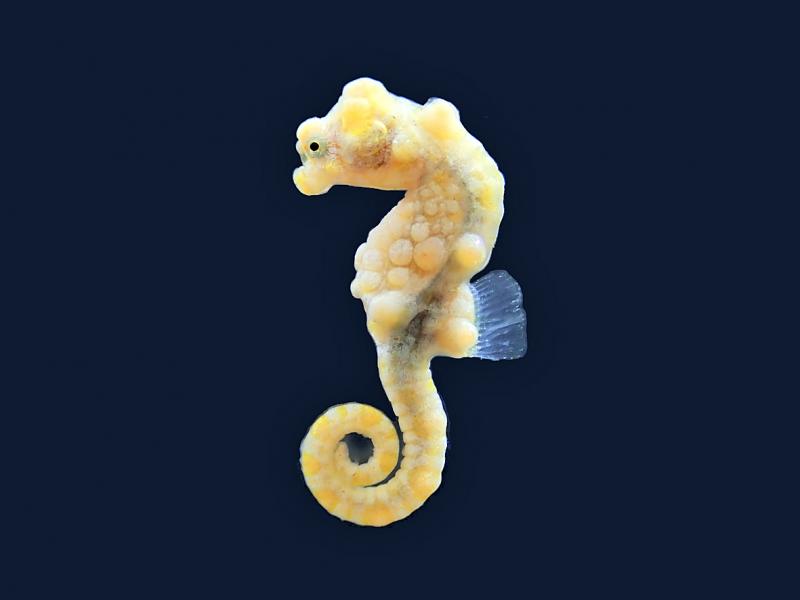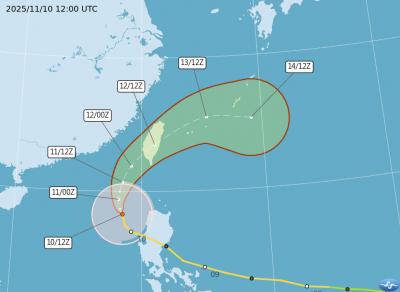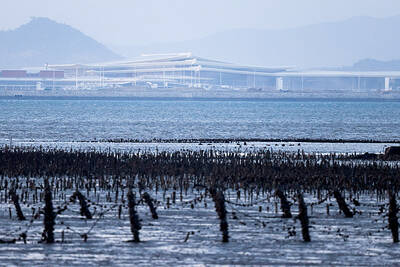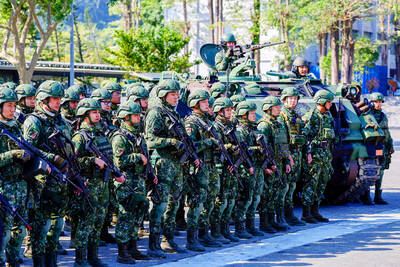A National Academy of Marine Research (NAMR) team last month found a species of pygmy seahorse for the first time near islands in Penghu County, the institute said yesterday.
The pygmy seahorse, known as Hippocampus bargibanti, was discovered 30 nautical miles (55.6km) southwest of Cimei (七美), the southernmost island in the Penghu archipelago, during a research trip, the academy said.
It is the first time the species — which is beloved by coral reef photographers for its “adorable” appearance — has been found in the area, it added.

Photo courtesy of the National Academy of Marine Research
The discovery indicates that the area of the Taiwan Strait where the species was spotted is suitable as a natural habitat for the pygmy seahorse, NAMR president Chiu Yung-fang (邱永芳) said.
The institute would continue its work to develop a better understanding of the area, which marine researchers did not begin to explore until last year due to strong currents and complex ocean floor terrain, she said.
During the trip, researchers used a small dredge net to collect samples from the seafloor, the institute said, adding that this is a common method of collecting samples from benthic zones.
Among the samples collected, the researchers found a pygmy seahorse, which was already dead, it said, adding that the animal would be used as a research specimen.
Pygmy seahorses have previously been found around Taiwan. According to the Fish Database of Taiwan, which is managed by Academia Sinica, the species was first discovered in Taiwanese waters in 2007, near Green Island (綠島).
Since then, pygmy seahorses have been spotted by recreational divers off northeastern, southeastern and southwestern Taiwan.
The pygmy seahorse is a tiny sea creature that measures less than 2cm in length, has a pinkish or yellowish body and usually attaches itself to vibrant corals, where it feeds on plankton.

The Central Weather Administration (CWA) today issued a sea warning for Typhoon Fung-wong effective from 5:30pm, while local governments canceled school and work for tomorrow. A land warning is expected to be issued tomorrow morning before it is expected to make landfall on Wednesday, the agency said. Taoyuan, and well as Yilan, Hualien and Penghu counties canceled work and school for tomorrow, as well as mountainous district of Taipei and New Taipei City. For updated information on closures, please visit the Directorate-General of Personnel Administration Web site. As of 5pm today, Fung-wong was about 490km south-southwest of Oluanpi (鵝鑾鼻), Taiwan's southernmost point.

UNILATERAL MOVES: Officials have raised concerns that Beijing could try to exert economic control over Kinmen in a key development plan next year The Civil Aviation Administration (CAA) yesterday said that China has so far failed to provide any information about a new airport expected to open next year that is less than 10km from a Taiwanese airport, raising flight safety concerns. Xiamen Xiangan International Airport is only about 3km at its closest point from the islands in Kinmen County — the scene of on-off fighting during the Cold War — and construction work can be seen and heard clearly from the Taiwan side. In a written statement sent to Reuters, the CAA said that airports close to each other need detailed advanced

Tropical Storm Fung-Wong would likely strengthen into a typhoon later today as it continues moving westward across the Pacific before heading in Taiwan’s direction next week, the Central Weather Administration (CWA) said. As of 8am, Fung-Wong was about 2,190km east-southeast of Cape Oluanpi (鵝鑾鼻), Taiwan’s southernmost point, moving westward at 25kph and possibly accelerating to 31kph, CWA data showed. The tropical storm is currently over waters east of the Philippines and still far from Taiwan, CWA forecaster Tseng Chao-cheng (曾昭誠) said, adding that it could likely strengthen into a typhoon later in the day. It is forecast to reach the South China Sea

Almost a quarter of volunteer soldiers who signed up from 2021 to last year have sought early discharge, the Legislative Yuan’s Budget Center said in a report. The report said that 12,884 of 52,674 people who volunteered in the period had sought an early exit from the military, returning NT$895.96 million (US$28.86 million) to the government. In 2021, there was a 105.34 percent rise in the volunteer recruitment rate, but the number has steadily declined since then, missing recruitment targets, the Chinese-language United Daily News said, citing the report. In 2021, only 521 volunteers dropped out of the military, the report said, citing